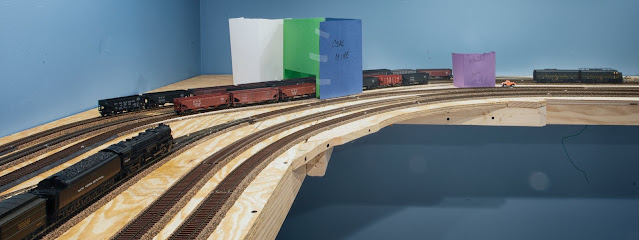11/22/20
Finally finished the coal mine, coal mine area scenery and mountains. About 3 weeks of work. Well, not exactly finished. Still some details to be added but the heavy lifting is done.
Now it is off to an area about 20 feet down the layout. This would be to the right of the coal mine down the long 41 foot wall.
I am test fitting building mockups for the towns of Fort Greene and Brooklyn Heights. In Brooklyn Heights I need to disguise, if possible, a 4 inch waste pipe. A two foot high hill may work.
Fort Greene and Brooklyn Heights will be separated by a creek and connected via a dual track truss bridge for the railroad mainline and a two lane vehicle bridge.
My artistic directors, Marianne and Sydney, are working on the next structure. Rather than choosing a basic plastic kit they opted for a Downtown Deco hydrocal kit. Nothing like working with 5 minute epoxy to test your skills.
Here is an image of them checking out some online how-to videos.
A few pics of the coal mine are below. I watched a 35 minute video by "Modeler Man Mike" on building and weathering this structure. Some good weathering tips that I can apply to other structures.
The kit simulates corrugated steel sheets and has vertical reliefs 2 scale feet apart. I added horizontal reliefs 11 scale feet apart. I checked steel sheeting online and they are sold in 2 ft x 12 ft sections. I assumed a 1 ft overlap. I do not know if this was the size used at the time a mine like this would have been built. Probably somewhere between the 1920's and 1940's.
First step was to spray the entire unassembled model with Krylon clear matte. To simulate wall sections that had been replaced I masked most of the wall areas and just had openings where I wanted to simulate new sections which I sprayed with Rustoleum silver metallic. These are the brighter areas of the walls.
The I added a few strips of Evergreen styrene to simulate repaired areas after spraying them with the metallic paint.
Then lots of weathering chalk brushed on.












































